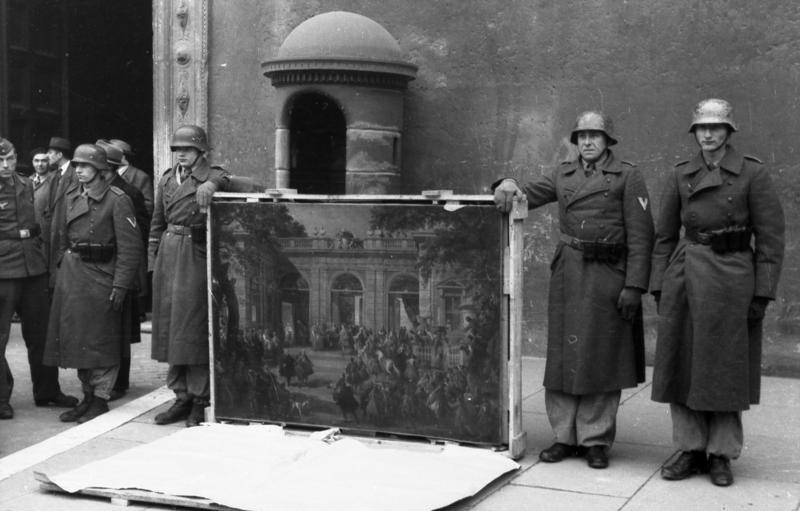German soldiers in 1944, posing with a picture by Giovanni Paolo Panini taken from Naples
Source: Wikimedia Commons
Source: Wikimedia Commons
We have just returned from a holiday in Berlin where quite a lot of time was spent at museums and monuments describing the rise of Nazism and the consequences of the Second World War. So it was something of a relief to spend a day at Sanssouci ('without worries'), the beautiful rococo summer palace of Frederick the Great, built to the design of Georg Wenzeslaus von Knobelsdorff between 1745 and 1747. There we saw the painting below, by Giovanni Paolo Panini, a vedute showing some architectural highlights of Baroque Rome. It came to Sanssouci in 1750 and was paired there with a similar painting showing the Forum and ancient Rome. Viewers could compare the two, like readers of the popular contemporary city guidebook Roma antica e moderna (1745), written by Gregorio Roisecco, who owned a bookshop at the Piazza Navona. What I like about Panini's painting is not the distant church spires and dome of St Peter's Basilica, but the foreground of fields and vineyards. This is now the district of Prati, described on websites as a 'white collar' area of 'high end shopping streets' and 'cool restaurants'.
Giovanni Paolo Panini, View of Rome from the foot of Monte Mario, 1749
My photograph in Sanssouci
When I included a Panini painting in my year of landscape art tweets, I made a bit of a lame joke comparing the collecting of Panini paintings by Grand Tourists with the collecting of Panini stickers by football fans. I don't think the Panini brothers, who founded their company in Modena in 1961, are related to the eighteenth century artist. But look at the painting below, now in the Met, and it is hard not to think of a Panini sticker album, like the ones I collected as a boy (I actually managed to complete the 1982 World Cup collection). In Panini's Ancient Rome (1757), the Count of Stainville, who commissioned the painting, can be seen in the middle with a guidebook, visiting an imaginary gallery in Rome. Panini himself is visible behind the chair. There is a companion painting to this that shows Modern Rome, now owned by the Museum of Fine Arts in Boston.
Giovanni Paolo Panini, Ancient Rome, 1757
Source: Wikimedia Commons
Frederick the Great built his own picture gallery between 1755 and 1764 which we saw on our trip to Sanssouci. However, only ten of the original paintings were retrieved after the war and although some more were brought back from the USSR in 1958, others remain in Russia. Theft is the dark side of the collecting impulse. One of the most widely reproduced photographs of Nazi looting, reproduced above, shows soldiers from the Hermann Göring Division posing with a Panini painting. Naturally there have been many instances of Panini sticker robberies, from the 300,000 packs stolen in Brazil in 2014 and the armed robbery at a printing house in Argentina in 2018, down to domestic burglaries targeting albums carefully assembled by individual collectors.
Engraved sheets from Roma antica e moderna
Of course sight-seeing itself is a form of collecting. The guidebook Roma antica e moderna laid out distinct itineraries for a ten day stay and included illustrations of each site. The photograph above shows a set of detached sheets that was up for sale, transforming the old book into a collection of collectible images. Another, earlier guidebook entitled Roma antica e moderna (published by Giordano Ziletti in 1558) contained a whole section listing every Roman statue still visible in the city. I wonder how many people (men!) went round and tried to tick them all off. Last week, looking at the sites in Panini's painting, I was enjoying a collection (of buildings) within a collection (of paintings), and this was itself part of the collection of places in and around Berlin that we made for ourselves during a week's holiday.




No comments:
Post a Comment